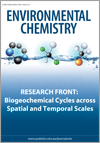
Environmental Chemistry
Volume 15 Numbers 1 & 2 2018
RESEARCH FRONT: Biogeochemical Cycles across Spatial and Temporal Scales
EN16203Time-resolved microbial guild responses to tidal cycling in a coastal acid-sulfate system
Environmental context. Microbes play key roles in controlling acidification and metal toxicity in coastal acid-sulfate soils. We characterised the time-dependent metabolic activities of abundant and rare taxa in acidifying tidal wetlands and showed that rare taxa exhibiting higher activity may exert significant influence on iron- and sulfur-cycling. Our findings yield new insights into the drivers and timing of iron- and sulfur-cycling in coastal acid-sulfate systems.
EN17124Evaluation of phosphate-uptake mechanisms by Fe(III) (oxyhydr)oxides in Early Proterozoic oceanic conditions
Environmental context. Reconstructing the Precambrian oceanic P cycle, in conjunction with the As cycle, is critical for understanding the rise of atmospheric O2 in Earth’s history. Bioavailable phosphorus (P) has been found to regulate photosynthetic activity, whereas dissolved arsenic (As) maxima correlate with photosynthetic minima. New data on empirical adsorption and coprecipitation models with Fe(III) (oxyhydr)oxides suggest coprecipitation is a more efficient method of P sorption than is adsorption in Precambrian surface ocean conditions.
EN17104The fate of arsenic in groundwater discharged to the Meghna River, Bangladesh
Environmental context. Arsenic contamination of groundwater is a major environmental problem in many areas of the world. In south-east Asia, iron-rich reducing groundwater mixes with oxidising river water in hyporheic zones, precipitating iron oxides. These oxides can act as a natural reactive barrier capable of accumulating elevated solid-phase concentrations of arsenic.
EN17106Ecological factors affecting the accumulation and speciation of arsenic in twelve Australian coastal bivalve molluscs
Environmental context. Knowledge of the pathways by which arsenic is accumulated and transferred in marine ecosystems is scarce. Molluscs are important keystone organisms providing a link between primary producers (micro and macroalgae) and higher trophic levels such as fish. The present study examines the accumulation and species of arsenic in common bivalve molluscs from south-east Australia to understand the cycling of arsenic in marine food webs.
EN17150On the nature of dissolved copper ligands in the early buoyant plume of hydrothermal vents
Environmental context. Copper released by deep-sea hydrothermal vents has been recognised to be partly stabilised against precipitation by its complexation with strong Cu binding ligands. Yet, the sources and nature of these compounds in such environments are still not fully understood. This study shows that the Cu ligands detected are hydrothermally sourced and could be mainly inorganic sulfur species.
EN17198The effect of diethylene glycol on pollution from offshore gas platforms
Environmental context. Marine mining activities are potential sources of environmental pollution. Diethylene glycol used in offshore platforms has been suspected to facilitate the release of toxic substances into the sea. The results obtained elucidate that this release is not significant for the metals examined here, apart from iron, nor for polycyclic aromatic hydrocarbons, even at very high diethylene glycol concentrations.
EN17212Mechanisms for ozone-initiated removal of biomass burning products from the atmosphere
Environmental context. An important product of biomass burning is catechol: its presence in the atmosphere can have adverse effects on health, and can lead to the formation of secondary organic aerosols. We report a theoretical study on the mechanisms and kinetics of removal of catechol from the atmosphere by reaction with ozone. These data will provide insight into the ozonolysis of other lignin compounds produced by biomass burning.
EN17192A rapid method for the analysis of perfluorinated alkyl substances in serum by hybrid solid-phase extraction
Environmental context. Although the environmental occurrence of perfluoroalkyl substances was first reported almost 20 years ago, there are continuing concerns about human exposure to these potentially toxic chemicals. Such concerns have necessitated the development of reliable methods for rapid determination of perfluoroalkyl substances in human serum. This article describes a rapid and sensitive analytical method suitable for monitoring human exposure to perfluoroalkyl substances.
EN17208Effective adsorptive removal of 2,4,6-trinitrotoluene and hexahydro-1,3,5-trinitro-1,3,5-triazine by pseudographitic carbon: kinetics, equilibrium and thermodynamics
Environmental context. Explosive organic compounds such as 2,4,6-trinitrotoluene (TNT) and hexahydro-1,3,5-trinitro-1,3,5-triazine (RDX) are major constituents of ammunition materials. These compounds are of environmental concern because they can have a significant impact on ecosystems and humans. Through investigations of adsorption kinetics, isotherms and thermodynamics, we demonstrate the suitability of pseudographitic carbon for removing TNT and RDX from groundwater, and additionally confirm the viability of the use of pseudographitic carbon through comparison with other adsorbents.
EN17199Latent disciplinal clashes concerning the batch dissolution of minerals, and their wider implications
Environmental context. Mineral dissolution kinetics are important to understand natural processes including those increasingly used to store waste carbon dioxide and highly radio-active nuclides, and those involved in the amelioration of climate change and sea-level rise. We highlight a mistake made in the fundamental science that has retarded progress in the field for over 40 years. Its removal suggests improved ways to approach dissolution studies.



